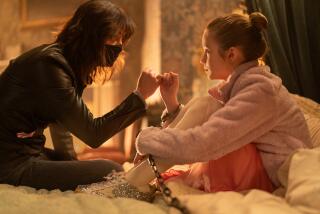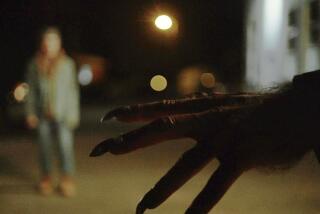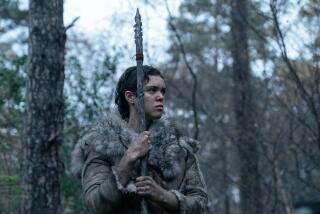How the makers of new ‘Halloween’ and ‘Suspiria’ films took different approaches reimagining hallowed horror classics
From “Get Out” to “A Quiet Place” to “It,” horror has rarely been hotter in Hollywood. And this October two especially ambitious genre updates hit the screen: David Gordon Green’s slasher sequel “Halloween” (Oct. 19), set 40 years after John Carpenter’s 1978 classic, and “Suspiria” (Oct. 26), a remake of Dario Argento’s iconic giallo, from “Call Me By Your Name” director Luca Guadagnino.
Both high-profile reimaginings arrive in back-to-back weeks before Halloween, helmed by trusted filmmakers with respected pedigrees. And both will face the ultimate scrutiny when horror fans put them to the test: Honorable follow-up to a beloved genre property, or straight up blasphemy?
No pressure, right?
“I’m not a fan of the original ‘Suspiria,’ to be honest,” screenwriter David Kajganich bravely admitted over the phone, bracing for the backlash from “Suspiria” diehards with a laugh. “I’m a fan of it as an art piece, but as a narrative it makes almost no sense.”
FULL COVERAGE: 2018 fall movie preview »
Kajganich and Guadagnino were working on “A Bigger Splash” when the Italian director floated his longtime dream of remaking “Suspiria,” to which he had procured the rights. But with a horror film as beloved as “Suspiria,” one of Argento’s best-known works, they knew they had to do it their own way — and “do it right.”
“And by right I mean not to copy the original, not to draft off of its concerns, but to really use the situations that are so versatile to talk about a whole range of things thematically,” Kajganich said.
Argento’s influential original 1977 film, a nightmarish kaleidoscope of phantasmagorical electric hues, follows an American ballet student (Jessica Harper) who encounters supernatural intrigue at a German dance academy.
The original “Suspiria” doesn’t do much to explore the concerns of the tumultuous world outside the school’s doors. Kajganich and Guadagnino sought to recontextualize the bones of its central story to reflect the political chaos happening in the world at the time Argento made his original film.
Their “Suspiria,” stars Dakota Johnson as Susie, an American dance student who arrives at the prestigious avant-garde dance company run in Berlin by Madame Blanc (Tilda Swinton). The disappearance of another dancer leads an elderly German psychoanalyst named Jozef Klemperer to play detective.
The new “Suspiria” very deliberately unfolds against the backdrop of 1977’s German Autumn with historic events like the hijacking of a Lufthansa airliner playing out on news reports, hinting at larger thematic concerns. As research, Kajganich dove into writings by women of the time, watched the films of New German Cinema auteur Rainer Werner Fassbinder, and even “listened to a lot of Nico” to set a mood.
“It was a fascinating moment in history because you had a generation of students and young people who were sick in their souls about how much denial there was in their parents and grandparents’ generations about German culpability in World War II,” said Kajganich.
“The city was immersed in that struggle, and in the middle of all of that — or rather, behind all of that — there is this dance company, where an American is getting her education in a way in how a modern kind of fascism might look.”
‘Halloween’ face-off
In bringing a new “Halloween” to the screen, Green and his collaborators were also mindful of how their film would bridge the decades since the original — and what modern audiences would bring to the story.
Their film, produced by Miramax, Trancas International Films and Blumhouse Productions and executive produced by Carpenter, picks up 40 years after the events of the original and canonically disregards the half-dozen other sequels that followed.
In 2018’s “Halloween,” killing machine Michael Myers is back to terrorize the ’burbs — as seen in a gory, atmospheric, unbroken tracking shot in the five-minute reel shown exclusively at Comic-Con in July.
First, however, the horror icon also known as the Shape has to go through Jamie Lee Curtis’ older, wiser — and battle-ready — Laurie Strode.
RELATED: Virtually every film coming out this fall »
“She has a line in the original film when she’s talking to young Tommy Doyle at the climax of the movie,” Green said of Laurie, who in the new film has been waiting decades to face off again with Myers. “She says, ‘Do as I say.’ And she says this line with a command that she hasn’t had for the entire film. Do as I say.”
“We took that to be her mantra for our film,” he continued. “She’s taken that pivotal moment in her life, and her recognition of facing her fears, and now has been chanting that in meditations for 40 years. She’s reached a point of a perceived almost psychosis of authority and built from this ambitious, kind of romanticized academic school girl into a woman that you don’t want to [mess] with.”
With great appreciation for the 1978 original, Green had to walk a tricky balance between homage and innovation as he led the “Halloween” sequel forward.
“To approach it with both honor and audacity was really important to me,” he said. “To service the characters that Carpenter created, the performance that Jamie Lee Curtis established, the music that is so genetically embedded in me to give me nightmares and keep me awake at night as a child … to try to do that to a new generation of children is very important.”
“At the same time I don’t want to lose sight of my personal vision as a filmmaker,” added Green, whose wide-ranging career includes “All the Real Girls,” “Pineapple Express,” “Stronger” and HBO’s “Eastbound & Down.”
“I feel like every movie I’ve made up to this point adds up to be ‘Halloween’ in some strange way, and that’s really important to me,” he said. “To have the ownership of a film that’s following in some extraordinarily significant footsteps.”
Green still found himself running ideas by Carpenter, who co-wrote the first two “Halloween” films with Debra Hill and recorded new music for the new film.
And without tipping his hat in the direction he’s taken the story, Green believes the real-world context of 2018 will inevitably shape how viewers see his “Halloween.”
“What the audience can bring to it in terms of what’s going on in the world, I think, is extraordinarily complex and is going to add to a very simplistic experience,” he explained. “Michael Myers hasn’t evolved as a character in any way, shape or form [since 1978]; he’s the essence of evil.”
“He has no character. He has no personality. He has no interests. He never has. He’s someone that is moving forward and reacting to the world around him, but not with any sort of conscious objective. And how the world around him reacts to his behavior is where our story comes to life.”
Are the makers of “Halloween” or “Suspiria” sweating the soon-to-be-revealed fan reactions to two of horror’s most beloved properties?
“It was only when I started to hear the really concerned rumblings of Argento superfans that I thought, ‘Uh oh!’” said Kajganich. “I wonder if people will let this be its own thing. And I completely get that — I have my list of 10 films that if anyone dares remake it, I will take to social media immediately.
“But,” he added, “I’m excited for it to come out because I know that it will divide people — and we always hoped that it would.”
More to Read
Only good movies
Get the Indie Focus newsletter, Mark Olsen's weekly guide to the world of cinema.
You may occasionally receive promotional content from the Los Angeles Times.







